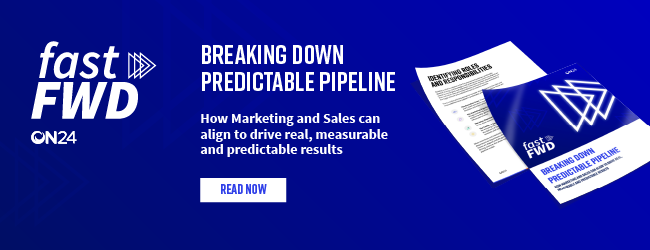Modern marketers have countless tasks and responsibilities as part of their job, all of which support the goal of going from generating demand to revenue activites. But how do exceptional marketers juggle it all? As part of our coverage of our Experiences Everywhere report, we explore how top marketers perform differently than mainstream marketers when generating demand and sales.
What Top Performers Do Differently
Some of the greatest things in life come in pairs: Batman and Robin, peanut butter and jelly, soap and water. Each dynamic duo is successful because it complements each other’s strengths and weaknesses. They’re stronger together than separate and neither element could function to the best of its abilities without the other half. The same is true for sales and marketing.
According to our report, top marketers, and their colleagues in sales, recognize this complementary nature and work together to achieve high levels of success. Though both top performers (91%) and mainstream (86%) marketers agree they have a solid relationship with sales, the results of our research show the most successful organizations have unparalleled strategic alignment and agreement.
Specifically, top performers (92%) affirmed that sales and marketing are tightly aligned on both how they define a qualified lead and how they’ll work together to realize demand to revenue objectives and goals. In comparison, only 63% of mainstream marketers agreed with these statements in relation to their organizations.
In addition to having a stronger relationship with their sales team, top-performing marketers are also providing sales colleagues with more useful information about prospects. The results were greatly varied when asked about the types of content that marketing typically provides to sales: primary research (55% vs. 40%), product/service collateral (54% vs. 48%), commercial insights (53% vs. 37%), case studies (47% vs. 57%), blog posts (47% vs. 35%), videos (45% vs. 41%), guides, (45% vs. 32%), webinars (39% vs. 40%), tip sheets (34% vs. 44%) and white papers (31% vs. 33%). This is especially important because 66% of B2B buyers want vendors to use more research and data in their content, as shown in previous research from an ON24 collaboration with Demand Gen Report.
Marketing and sales both strive to generate leads that turn into customers, but successful marketers recognize that quantity and quality often have vastly different outcomes in whether a lead becomes a customer. When a marketing team provides low-quality leads, it weakens their position, effectiveness and credibility within the larger organization.
Top-performing marketers are aware of this and more often agree when asked whether their sales team “believes the MQLs we send are viable and truly qualified.” Of those that agree or strongly agree with this statement, 80% are classified as top performers and 49% are mainstream.
One of the major keys to success for today’s B2B marketer is the ability to adapt and grow their marketing program with changes in their audiences. Top marketers are more than four times as likely to have highly scalable go-to-market programs than mainstream marketers (57% vs. 14%). When asked “How scalable is your current go-to-market program when it comes to supporting the goals of sales, marketing and customer success” mainstream marketers were more likely to report their program was somewhat scalable with 62% of respondents compared to 38% of top performers.
Lastly, one of the reasons successful marketers are at the top of their game is because they understand and manage the nuances of marketing to different audiences. It’s a rare situation in B2B marketing where one person makes the purchase decision. More frequently, there are several people tasked with reviewing new products or solutions and deciding which best fits the business’ needs.
Top marketers are aware of this, plan for it and create content that addresses the different roles within prospects’ buying committees. The research question specifically asked marketers to rate their level of agreement in whether their “marketing efforts are specifically created for the different personas in a target account’s buying committee.” Of those agreeing with the statement, 88% were top performers and 60% were mainstream.
Tips and Tricks for Generating Demand and Sales Like a Top Performer
Today’s marketing professional is now involved in more stages of the buying journey than ever before so it’s even more important to understand how to best reach target audiences and produce the results you want. Here are a few tools and suggestions to create and take advantage of demand generation.
Take advantage of webinars to accelerate the buying journey.
Research from Forrester/SiriusDecisions’ 2020 B2B Buyers Study found B2B buyers typically need 11 to 17 touches to work their way through the buyer’s journey. Webinars are excellent tools for delivering all types of content to prospects and customers, but one of their main benefits is the ability to provide multiple touches through a single event which helps accelerate prospects through the buying journey.
Track specific analytics to get richer engagement data.
Live webinars produce a wealth of information about participants, but did you know recorded webinars that are viewed later on-demand can provide just as much, if not more? Pay attention to specific details of your back-end analytics like who re-watched recordings, how many times they accessed the video and how long they watched. This information can tell you which parts of your webinars resonate with participants, which parts fizzle out and help you structure your content in a more impactful manner for your participants.
Revisit your audience personas for 2020.
It’s pretty safe to say 2020 is not what anyone expected. The world has radically shifted in a very short time, and pre-COVID-19 assumptions probably need to be updated. Audience priorities, buying decisions and pain points need to be reevaluated to ensure they align with today’s life and business. If you haven’t already, review generated demand from previous years and make necessary edits to your target audience personas so your efforts resonate.
Align sales and marketing teams for optimal cohesion and performance.
The relationship between sales and marketing has always been vital but rarely leveraged to the best of its ability. Top performers have demonstrated that a close working relationship between sales and marketing is necessary to achieve the goals of both departments. SiriusDecisions finds the relationship so important that it’s one of three fundamental pillars of their Demand Spectrum, a theoretical framework for marketing and sales to “define a range of marketing approaches and determine which approach is best suited to each demand situation” to ultimately drive revenue. The frequency of marketing and sales interactions and the content of their collaboration determines their ability to achieve common goals.



